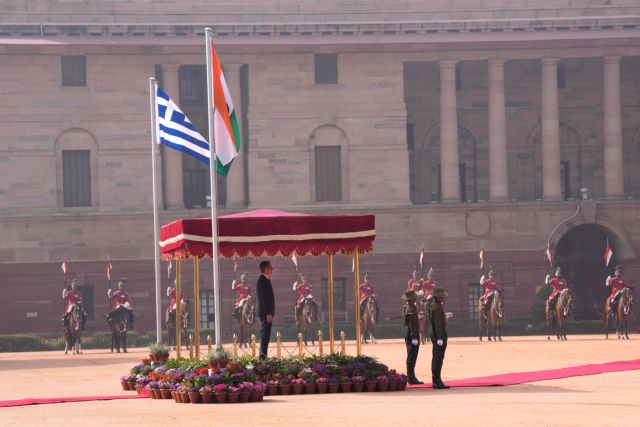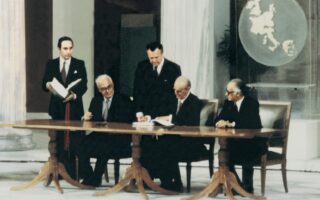Why the Brits gave Greece a bad name – in India

This should be an exciting time in the long story of the Greeks and the Indians. Leaders of the two countries have exchanged spectacular visits and under their benign gaze, scholars from both places have gathered to compare erudite notes about the many interactions between their ancient civilizations, or rather the multiple civilizations in which Greeks and Indians have been creatively involved.
One potentially helpful contribution to this dialogue is the work of Angeliki Kottaridi, founder of the new Polycentric Museum of Aigai and one of Greece’s most famous archaeologists and public educators.
Among her declared ambitions is to promote a more subtle understanding of the Hellenistic world – in other words, the space between North Africa and South Asia where Greek cultural forms, in rich interaction with local cultures and languages, served as a catalyst for creativity. As Kottaridi eloquently describes it, the Hellenistic city was not a place where one culture or economic system was imposed from above. On the contrary, it was a locus of encounter in which ideas and aesthetic principles could morph, fuse and explode in many directions. Hellenistic influence served as a kind of yeast, not an imperially imposed straitjacket.
Strangely enough, almost the only place where Hellenism did not have a very interesting aesthetic effect was Rome – whose sculptors and artists merely threw themselves into copying Greek models, with varying degrees of accuracy, without bringing any strong sensibility of their own into the mix.
This pattern emerges clearly in a careful study of the funerary art of Egypt in late antiquity. Lifelike Fayum portraits have features and techniques which follow a style established in Greece centuries earlier, and also characteristics which reflect local Egyptian conditions. It flourished under a Roman regime, but there is nothing particularly Roman about the style.
That vision of the Hellenistic world, so familiar to the poet C.P. Cavafy but not always grasped in the confines of the Greek nation-state, could be a useful element in a productive Greek-Indian conversation – delving into the shadowy but tantalizing world of Hellenistic cities and kingdoms which flourished on the northern edge of the Indian subcontinent.
Sadly though, there are clouds on the Greek-Indian horizon, for reasons that people in Greece would find utterly bewildering – but need to understand.
Because some of the first people to identify and celebrate the encounter between Hellenic forms and Buddhist ideas were envoys of the British Empire, the term “Greco-Buddhist” has become tainted in many Indian eyes. In some scholarly circles, any acknowledgement of Greek influence is avoided, and a new conventional wisdom ascribes all European features in early Buddhist art to trading links with Rome. A surreal search is under way to find alternative, non-Greek explanations for the flowing garments and noble physiognomies with which Buddha and other holy figures are depicted.
Well, interrogating the agenda of colonial art historians seems entirely valid, but canceling the influence of Greece – whose modern representatives have their own gripes with British antiquarianism, starting with the Parthenon Sculptures – is surely the wrong response.
What apparently overshadows the Greek connection in the eyes of Indians is a double association with conquest: first the expeditions of Alexander the Great, and then the enthusiasms of British colonialists who studied classics at their private schools. That is where the insights of Kottaridi, showing Hellenism as a liberating catalyst rather than a conquering force, might be helpful.
Of course, it should always be acknowledged that cultural transmission is a mysterious process and artistic developments can have multiple causes. It is possible – indeed likely – that the massive underlay of Hellenistic influence which preceded the flowering of Buddhist sculpture was topped up, so to speak, by trade with Hellenistic Egypt.
But at its most zealous, the new anti-Greek orthodoxy ignores the aesthetic evidence and invents imaginary chronological problems, to “prove” that any Western influence on Buddhist art was Roman and not Greek.
Ironically enough, the influence of this distorted view has spread to Britain. Take a new book (“Gandharan Art and the Classical World, A Short Introduction,” Archaeopress) by Peter Stewart, an Oxford scholar.
The content of the book is erudite and well-balanced but the author feels obliged to affirm – clearly in deference to his Indian colleagues – that the term Greco-Buddhist, as a description of artifacts or artistic techniques, is a “deeply deceptive” one. Deeply deceptive? Surely not. But it has evidently become, in certain contexts, offensive. Clearly some new terminology should be invented.
This is one of the many things that Greeks and Indians need to talk more about. But perhaps all British people, whether colonial or anti-colonial, should be asked to leave the room.
Bruce Clark is a member of the British Committee for the Reunification of the Parthenon Marbles.





